Attached files
| file | filename |
|---|---|
| 8-K - FORM 8-K - Encompass Health Corp | form8k-2009q4.htm |
| EX-99.1 - EXHIBIT 99.1 - Encompass Health Corp | exhibit99-1.htm |
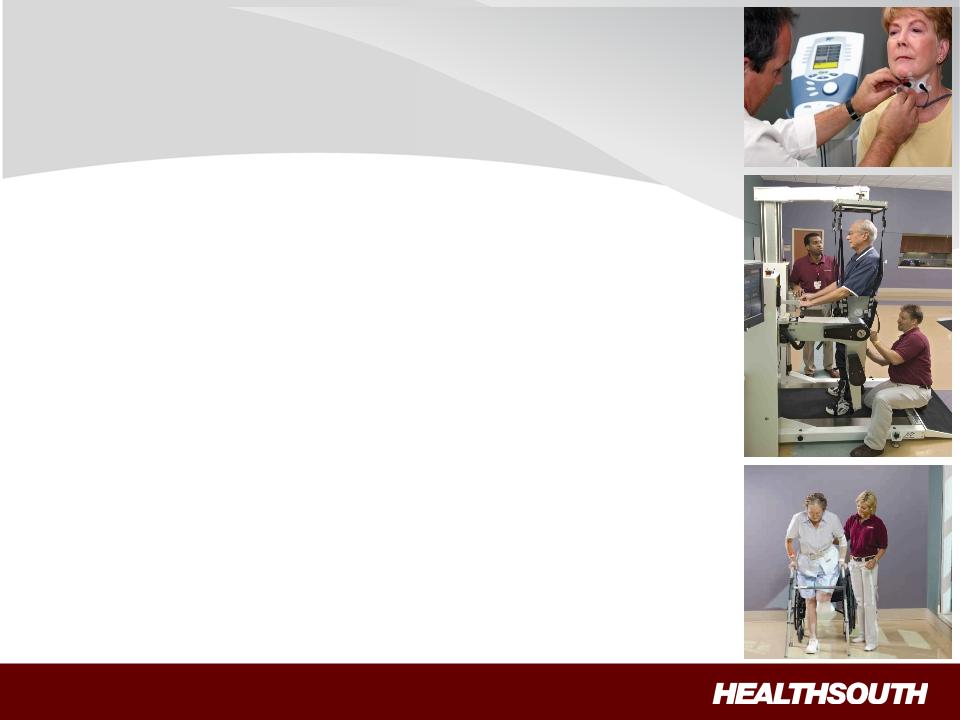
1
Fourth
Quarter 2009
Earnings
Call
Supplemental Slides
Supplemental Slides
Exhibit
99.2
Exhibit
99.2
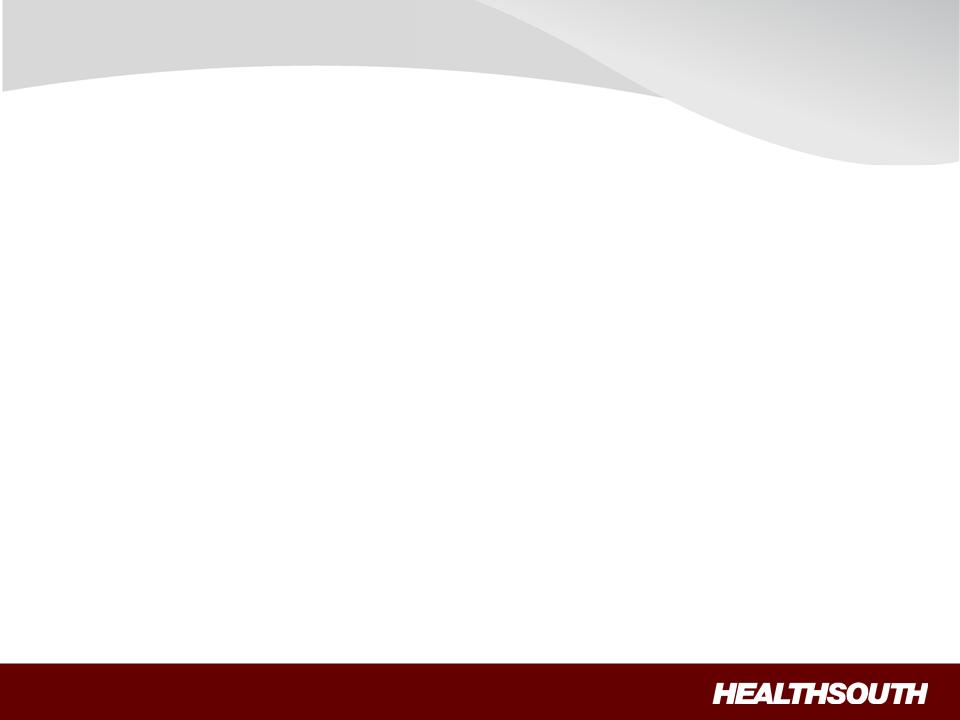
2
The
information contained in this presentation includes certain estimates,
projections and other forward-
looking information that reflect our current views with respect to future events and financial performance.
These estimates, projections and other forward-looking information are based on assumptions that
HealthSouth believes, as of the date hereof, are reasonable. Inevitably, there will be differences between
such estimates and actual results, and those differences may be material.
looking information that reflect our current views with respect to future events and financial performance.
These estimates, projections and other forward-looking information are based on assumptions that
HealthSouth believes, as of the date hereof, are reasonable. Inevitably, there will be differences between
such estimates and actual results, and those differences may be material.
There
can be no assurance that any estimates, projections or forward-looking
information will be realized.
All
such estimates, projections and forward-looking information speak only as of the
date hereof.
HealthSouth undertakes no duty to publicly update or revise the information contained herein.
HealthSouth undertakes no duty to publicly update or revise the information contained herein.
You
are cautioned not to place undue reliance on the estimates, projections and
other forward-looking
information in this presentation as they are based on current expectations and general assumptions and
are subject to various risks, uncertainties and other factors, including those set forth in our Form 10-Q for
quarters ended March 31, 2009, June 30, 2009, and September 30, 2009, and the Form 10-K for the year
ended December 31, 2009, when filed, and in other documents we previously filed with the SEC, many of
which are beyond our control, that may cause actual results to differ materially from the views, beliefs and
estimates expressed herein.
information in this presentation as they are based on current expectations and general assumptions and
are subject to various risks, uncertainties and other factors, including those set forth in our Form 10-Q for
quarters ended March 31, 2009, June 30, 2009, and September 30, 2009, and the Form 10-K for the year
ended December 31, 2009, when filed, and in other documents we previously filed with the SEC, many of
which are beyond our control, that may cause actual results to differ materially from the views, beliefs and
estimates expressed herein.
Note
Regarding Presentation of Non-GAAP Financial Measures
The following presentation includes certain “non-GAAP financial measures” as defined in Regulation G
under the Securities Exchange Act of 1934. Schedules are attached that reconcile the non-GAAP financial
measures included in the following presentation to the most directly comparable financial measures
calculated and presented in accordance with Generally Accepted Accounting Principles in the United
States. Our Form 8-K, dated February 22, 2010, to which the following supplemental slides are attached as
Exhibit 99.2, provides further explanation and disclosure regarding our use of non-GAAP financial
measures and should be read in conjunction with these supplemental slides.
The following presentation includes certain “non-GAAP financial measures” as defined in Regulation G
under the Securities Exchange Act of 1934. Schedules are attached that reconcile the non-GAAP financial
measures included in the following presentation to the most directly comparable financial measures
calculated and presented in accordance with Generally Accepted Accounting Principles in the United
States. Our Form 8-K, dated February 22, 2010, to which the following supplemental slides are attached as
Exhibit 99.2, provides further explanation and disclosure regarding our use of non-GAAP financial
measures and should be read in conjunction with these supplemental slides.
Forward-Looking
Statements
Exhibit
99.2
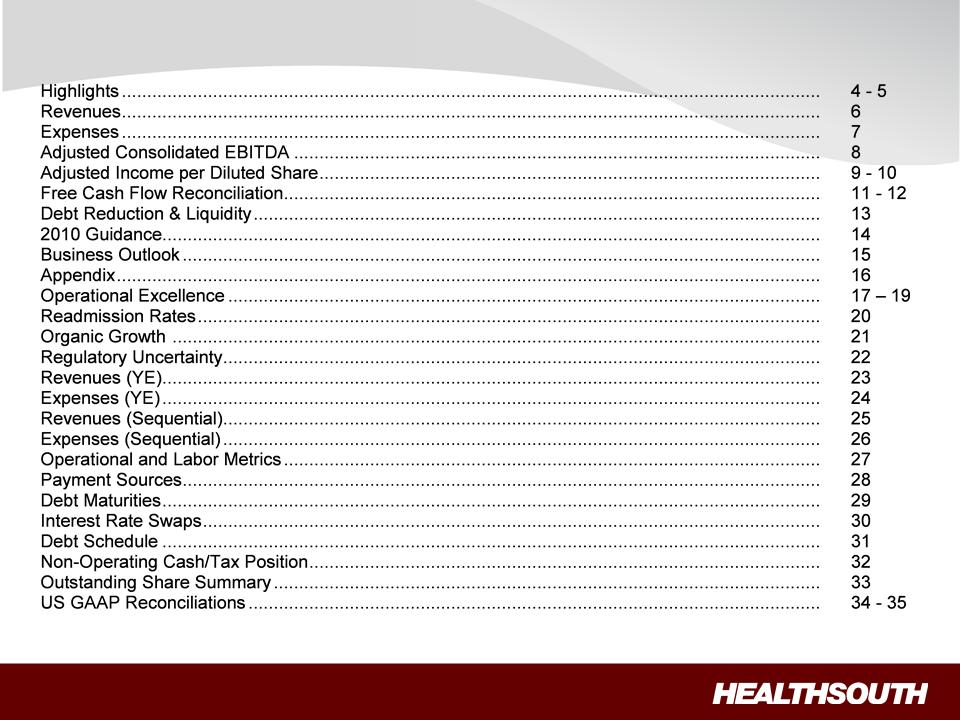
3
Table
of Contents
Exhibit
99.2
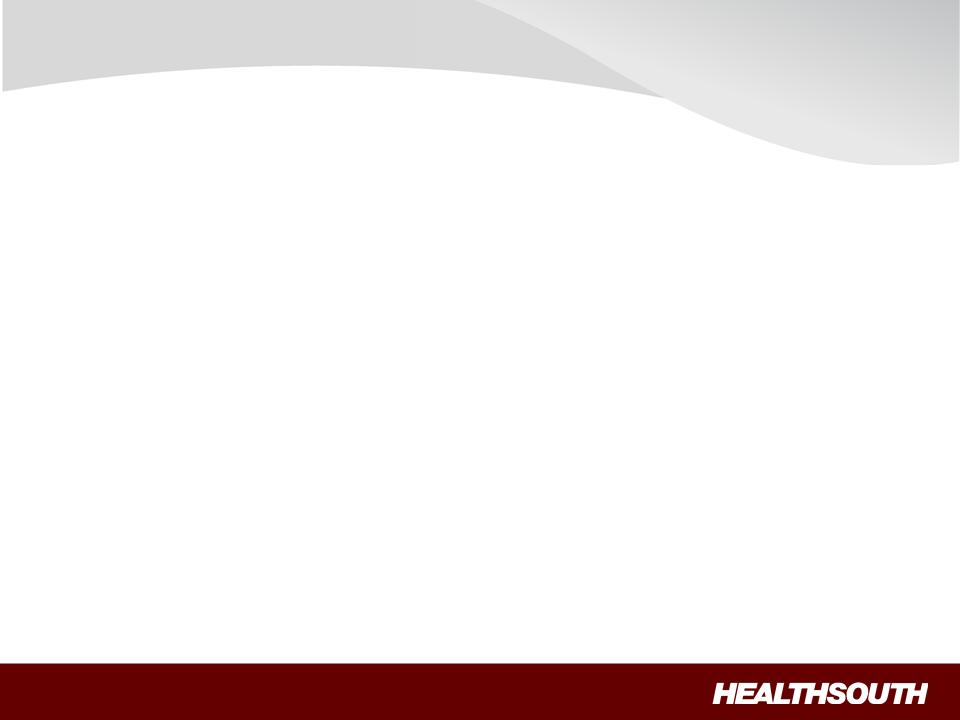
4
Highlights
(Q4 2009)
Goal
One - Organic Growth
ü Achieved 4.6%
quarter-over-quarter discharge growth.
– Same store discharge
growth was 4.2%.
ü Revenue growth of
5.5%.
– Driven by higher
discharge volume and Medicare market basket increase of 2.5%
effective October 1, 2009.
effective October 1, 2009.
ü High-quality,
cost-effective, patient care.
– Continued labor
productivity gains.
Goal
Two - Delever the Balance Sheet
ü Reduced debt by
$34.2 million during the quarter.
ü Completed amendment
and extension of the term loan facility and refinancing of floating
rate notes due 2014.
rate notes due 2014.
Goal
Three - Disciplined, Opportunistic Growth
ü Successful start-up
of Mesa, AZ, 40-bed inpatient rehabilitation hospital.
ü Expanded joint
venture with St. Vincent Health System in Little Rock, AR, through the
purchase of a 23-bed rehabilitation unit.
purchase of a 23-bed rehabilitation unit.
ü Acquired a
rehabilitation unit in Altoona, PA, through a newly formed joint venture
and
relocated its operations to one of our hospitals.
relocated its operations to one of our hospitals.
Exhibit
99.2
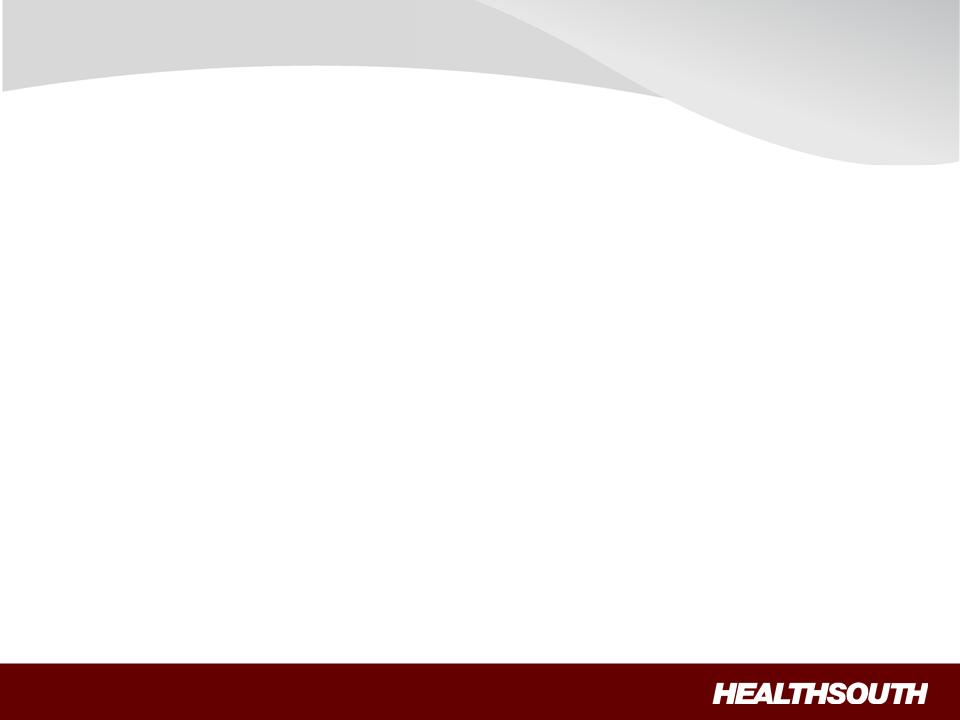
5
Highlights (2009)
Goal
One - Organic Growth
ü Achieved 5.4%
year-over-year discharge growth through our sales and marketing
initiative.
ü Successful start-up
of Mesa, AZ, 40-bed inpatient rehabilitation hospital.
ü Added capacity for
approximately 100 beds at existing hospitals.
ü Broke ground on a
40-bed inpatient rehabilitation hospital in Loudoun County, VA.
Goal
Two - Delever the Balance Sheet
ü Reduced debt by $151
million and leverage from 5.3x to 4.3x(1).
ü Completed capital
structure enhancements.
Goal
Three - Disciplined, Opportunistic Growth
ü Expanded joint
venture with St. Vincent Health System in Little Rock, AR, through the
purchase of a 23-bed rehabilitation unit.
purchase of a 23-bed rehabilitation unit.
ü Acquired a
rehabilitation unit in Altoona, PA, through a newly formed joint venture
and
relocated its operations to one of our hospitals.
relocated its operations to one of our hospitals.
ü Announced that our
joint venture with Wellmont Health Systems will open a new, 25-bed
inpatient rehabilitation hospital in Bristol, VA, in Q3 2010.
inpatient rehabilitation hospital in Bristol, VA, in Q3 2010.
(1) Based
on four quarter trailing Adjusted Consolidated EBITDA of $383.0 million and
$341.2 million, respectively; see related debt schedule on
slide 31 and reconciliation to GAAP on slides 34 through 35.
slide 31 and reconciliation to GAAP on slides 34 through 35.
Exhibit
99.2
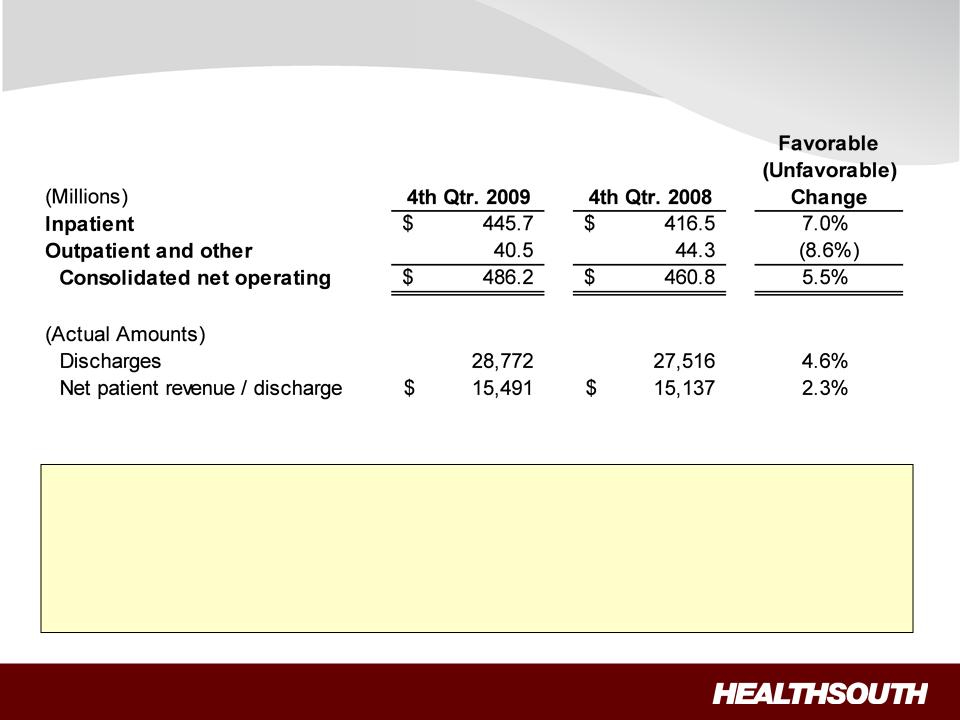
6
Revenues
(Q4 2009 vs. Q4 2008)
• Inpatient
revenue growth was driven by strong discharge volumes in Q4 2009 despite
tough
comparisons in Q4 2008.
comparisons in Q4 2008.
– Volume growth was
driven by the sustained sales and marketing effort.
– Same store discharge
growth was 4.2%.
– Pricing reflects
2.5% Medicare market basket increase effective October 1, 2009.
• Outpatient
revenue declined as a result of 10 fewer outpatient satellites quarter over
quarter.
Exhibit
99.2
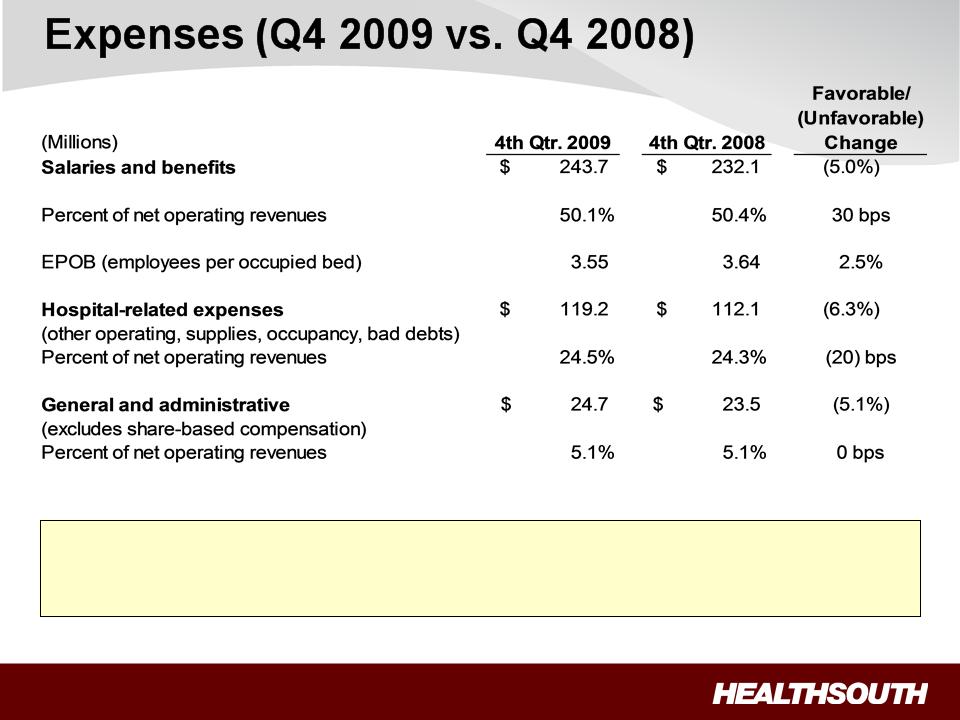
7
• Salaries
and benefits increased as a result of an October 1, 2009, 2.3% merit
increase.
– Continued
improvement on labor productivity demonstrated by lower EPOB.
• Hospital-related
expenses increased as a result of higher discharge
volume.
Exhibit
99.2
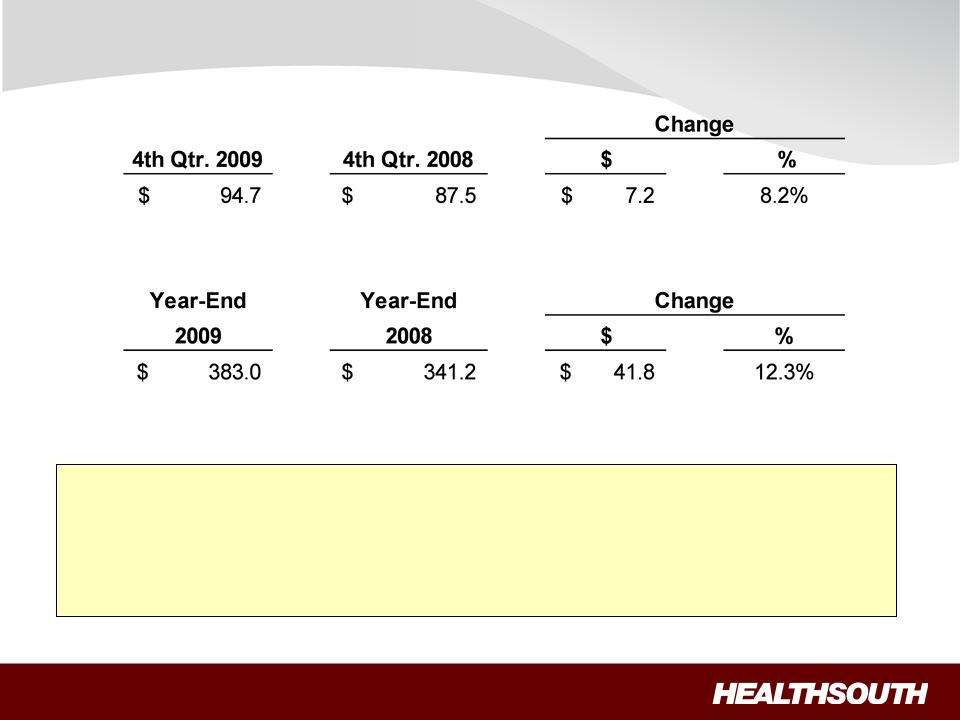
8
Adjusted
Consolidated EBITDA (1)
(Millions)
(Millions)
(1) Reconciliation
to GAAP provided on slides 34 through 35.
• Improvements
driven by:
– Increased
volumes
– Improved labor
productivity
– Disciplined expense
management
– 2.5% Medicare market
basket increase effective October 1, 2009
Exhibit
99.2
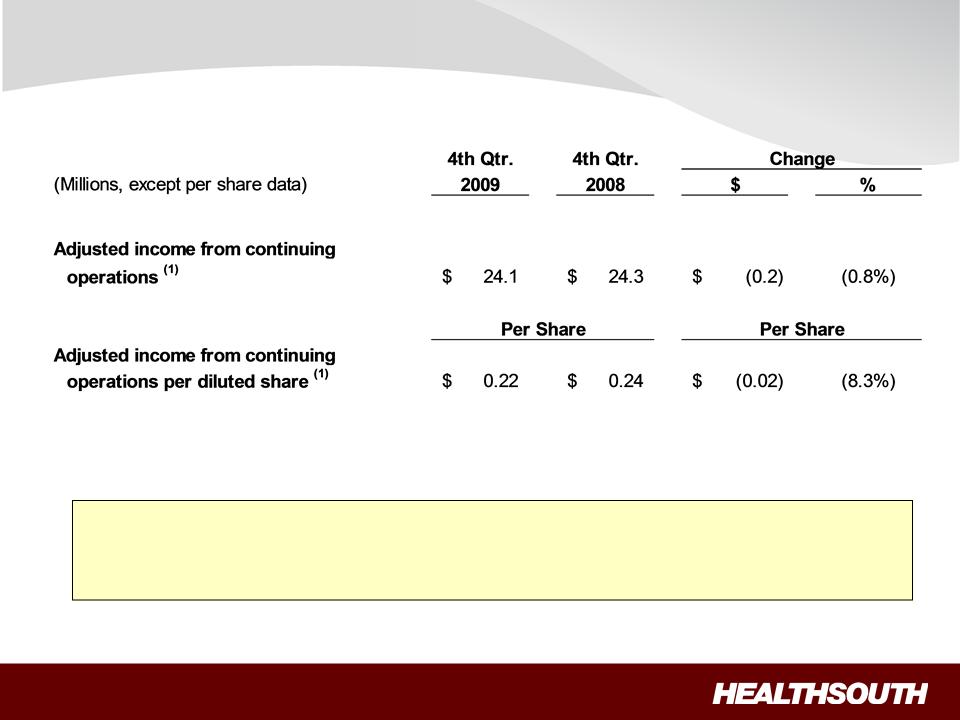
9
Adjusted
Income per Diluted Share (4Q 2009)
(1) Reconciliation
to GAAP provided on slides 34 through 35.
• The
improvement in adjusted earnings per share, driven by higher Adjusted
Consolidated EBITDA and lower interest expense, was offset by a $15.6 million loss on
early extinguishment of debt.
Consolidated EBITDA and lower interest expense, was offset by a $15.6 million loss on
early extinguishment of debt.
– Interest expense was
lower as a result of lower debt balances and a lower LIBOR
rate.
Exhibit
99.2

10
(1) Reconciliation
to GAAP provided on slides 34 through 35.
Exhibit
99.2
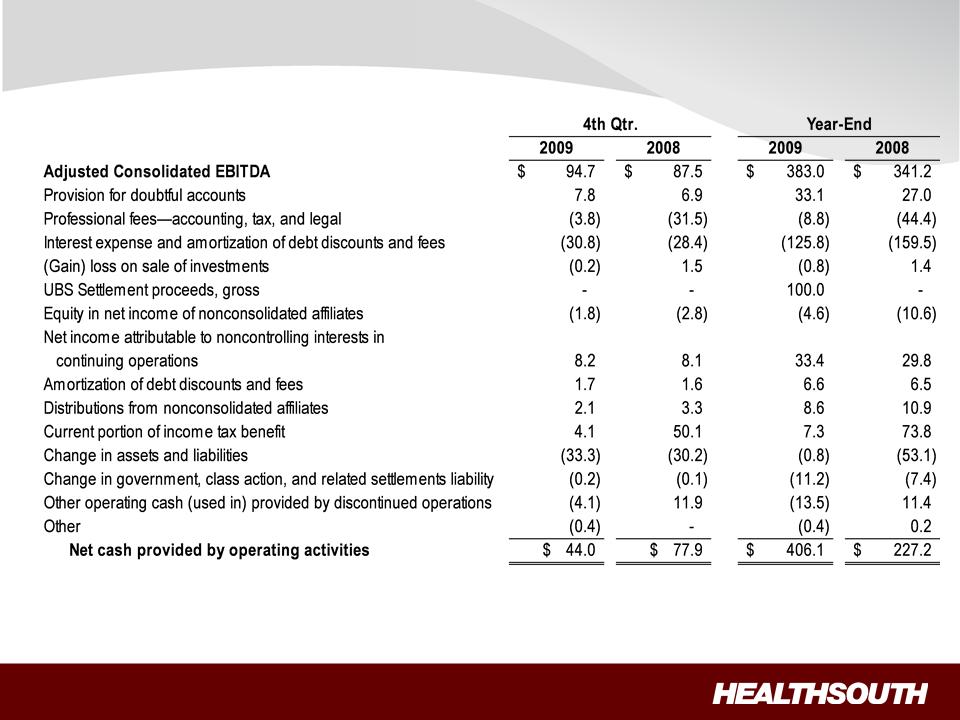
11
Free
Cash Flow Reconciliation: Adjusted Consolidated EBITDA
(1) to Net Cash Provided by Operating Activities
(1) to Net Cash Provided by Operating Activities
(1) Notes on page
35.
Exhibit
99.2
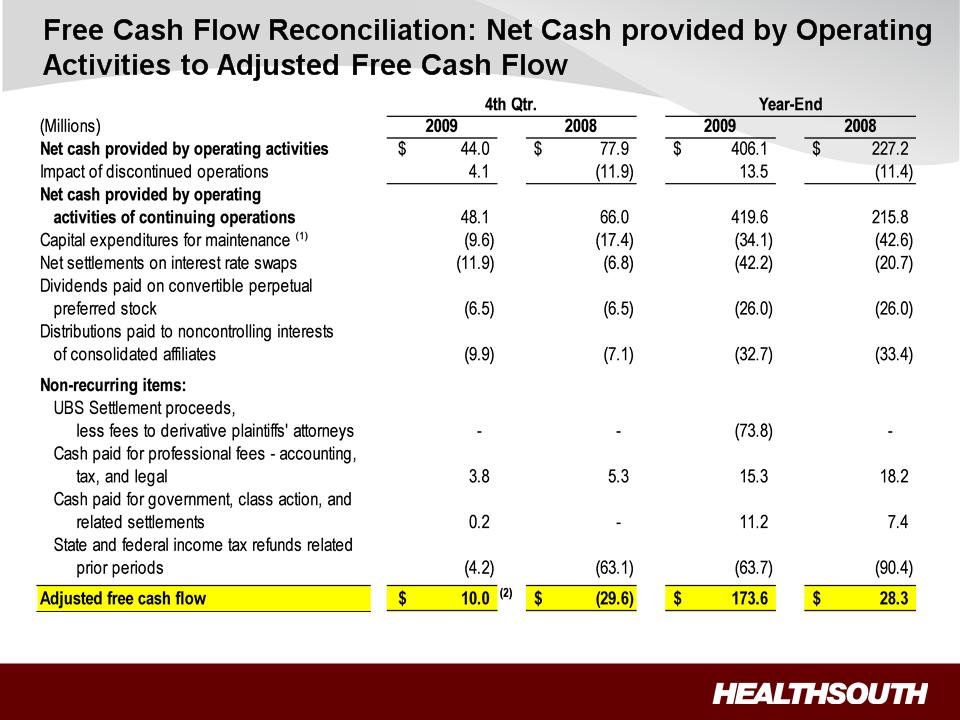
12
(1) Includes
capital expenditures for the hospital refresh program.
(2) Reflects
seasonal use of cash related to interest and insurance
payments.
Exhibit
99.2
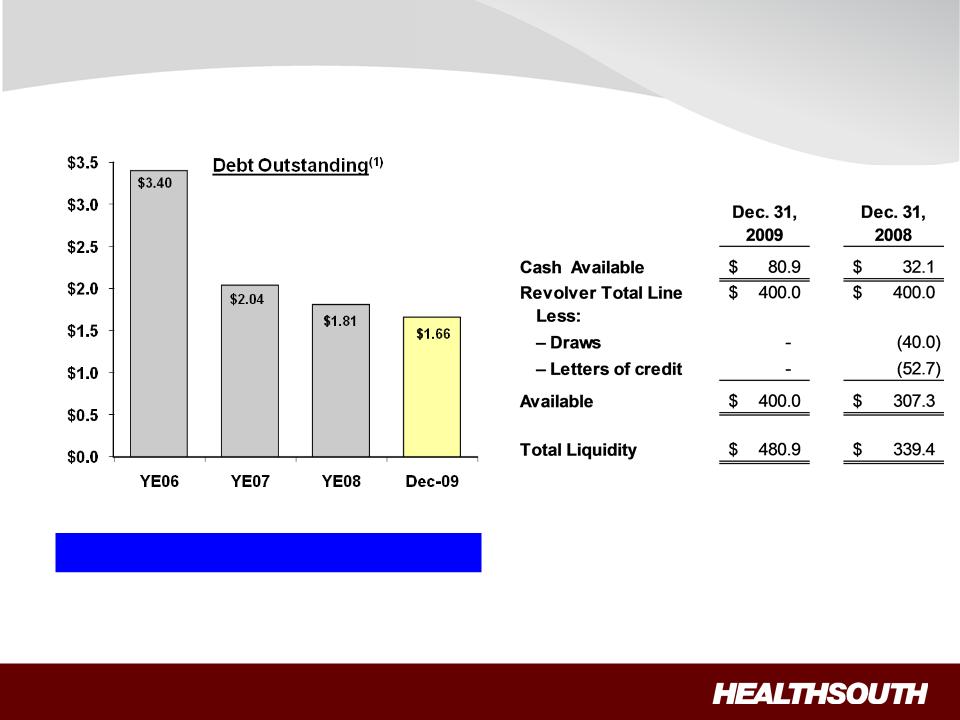
13
(1) Based on
four quarter trailing Adjusted Consolidated EBITDA of $383.0 million; see
related debt schedule on slide 31, and reconciliation to
GAAP on slides 34 through 35.
GAAP on slides 34 through 35.
Debt to
EBITDA 6.3x 6.3x 5.3x 4.3x
(1)
($
Billions)
Year-End 2011 Goal: 3.5x to
4.0x
Debt
Reduction and Liquidity
Liquidity
Exhibit
99.2
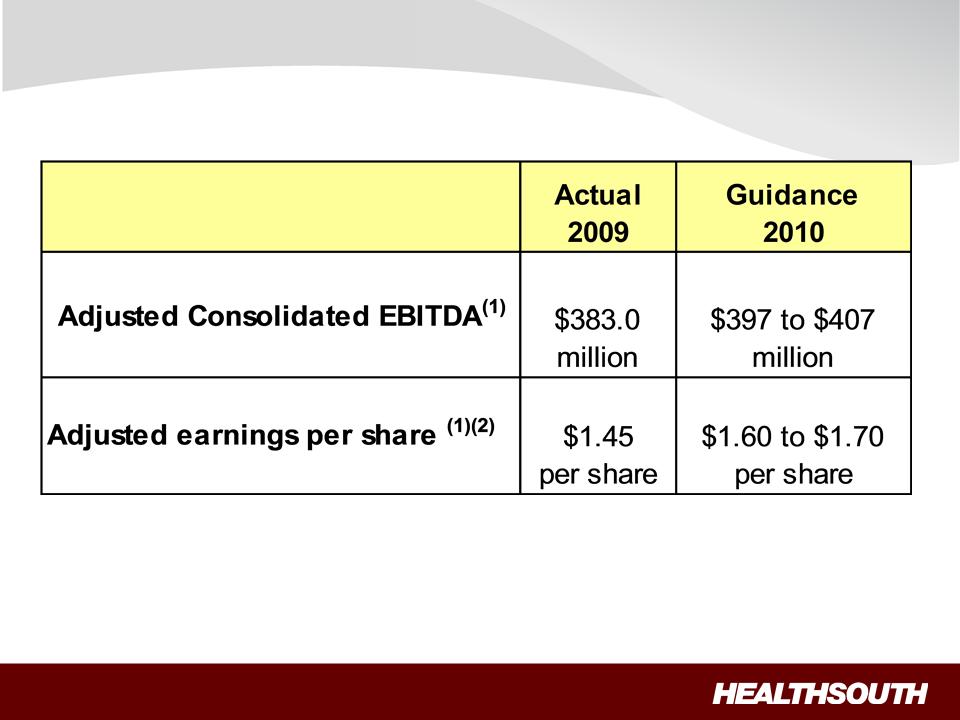
14
2010
Guidance (1)
(1) Reconciliation
to GAAP provided on slides 34 through 35.
(2) Adjusted
income from continuing operations per diluted share.
Exhibit
99.2
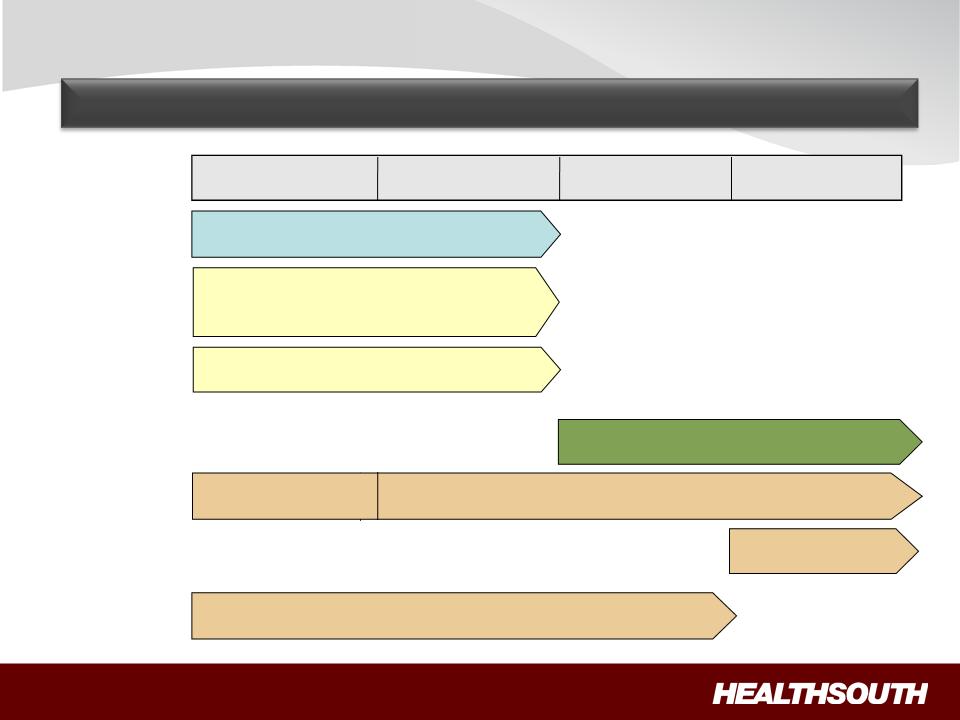
15
Business
Outlook
3.5x to
4.0x Debt to EBITDA (by YE 2011)
(Exclusive of any E&Y
settlement)
Organic
growth through capacity
expansion and de novos
expansion and de novos
(~ $60
million in 2010)
IRF
acquisitions/joint ventures
Deleveraging
Growth
Acquisitions of
other,
complementary post-acute services
complementary post-acute services
Reform
1.Pricing
2.Bundling
Sector
Regulation
Regulation
Pilot/Demonstration
Projects
Projects
• LTCH: admission
criteria; 25% Rule; MMSEA extension
• Home Health:
outliers; reimbursement methodology
Deleveraging,
Growth, Reform and Sector Regulation
No
change Unknown
at this
time
2010 2011 2012 2013
Exhibit
99.2
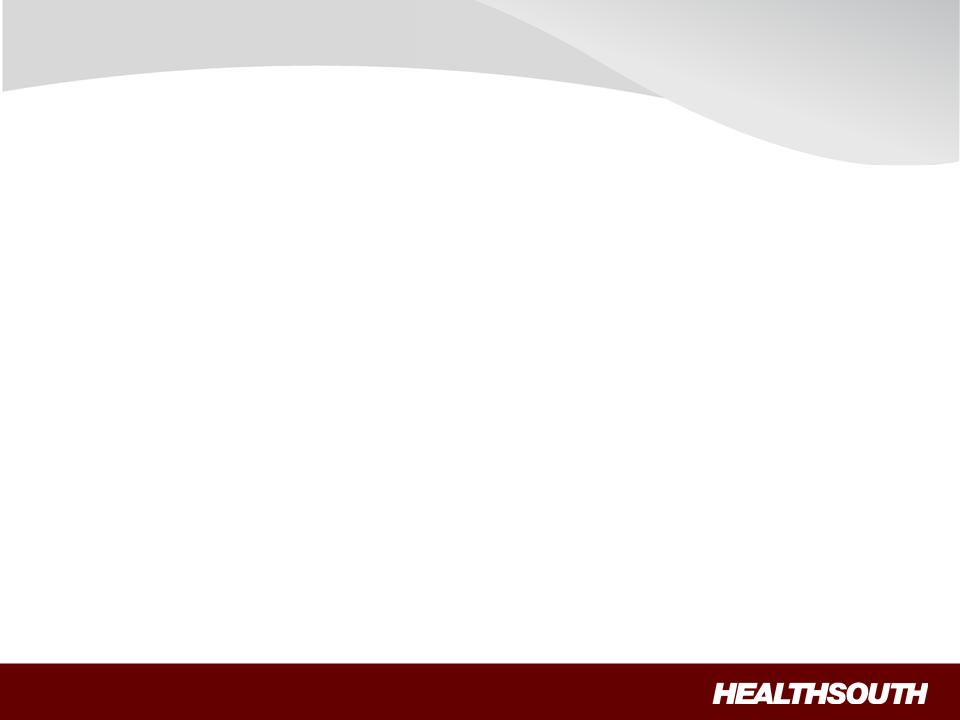
16
Appendix
Exhibit
99.2
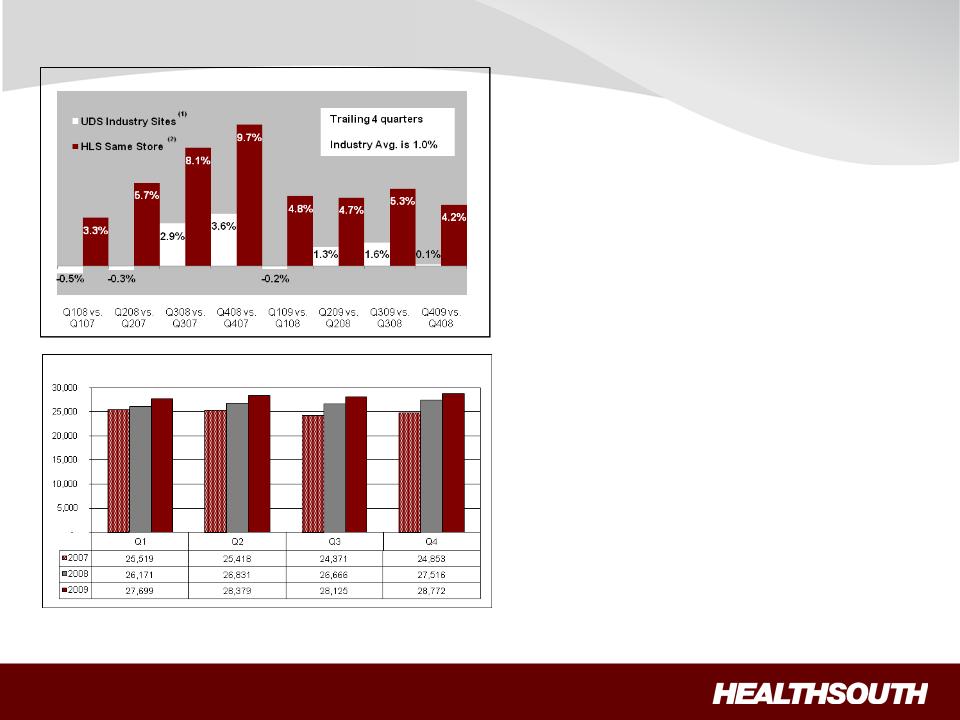
17
(1) Data provided by
UDSMR, a data gathering
and analysis organization for the rehabilitation industry; represents ~ 65-70%
of industry, including 90 HealthSouth sites.
(2) Includes 90
consolidated HealthSouth inpatient rehab hospitals and six long-term acute-care
hospitals.
Operational
Excellence: Sustained
Market Share Gains
HealthSouth
vs. Industry
Quarterly
Discharges
ü HealthSouth’s volume
growth
has outpaced competitors’
has outpaced competitors’
ü TeamWorks =
standardized
sales & marketing
sales & marketing
ü Capacity expansions
will help
facilitate organic growth:
facilitate organic growth:
Ÿ ~ 100
new beds 2009
Ÿ ~ 100
new beds 2010
Exhibit
99.2
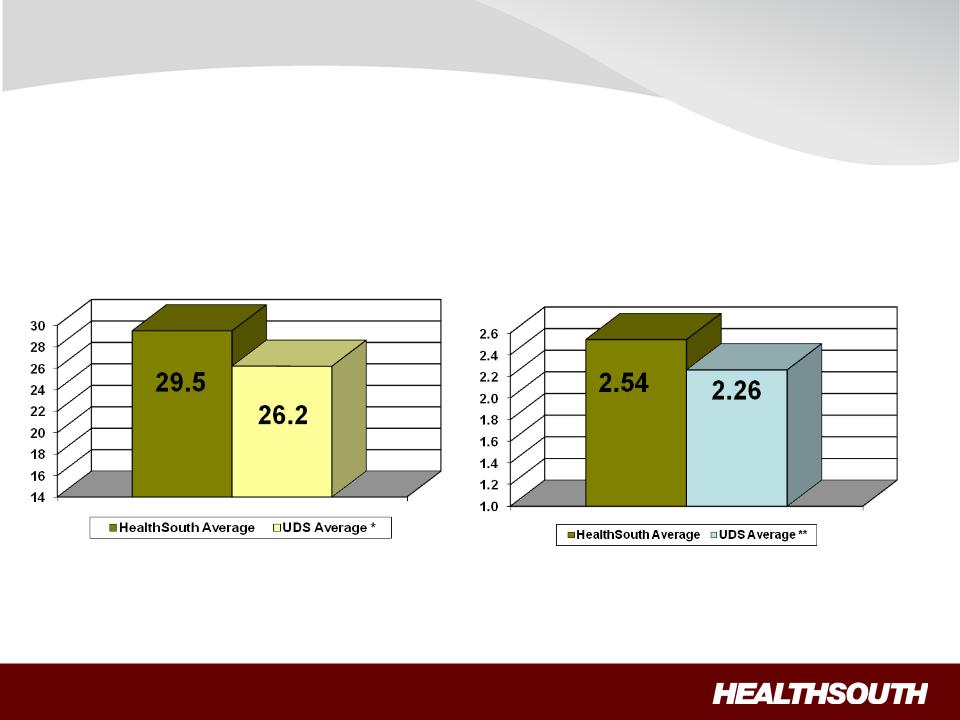
18
FIM
Gain
LOS
Efficiency
LOS
Efficiency
=
Functional gain
divided by length of stay
divided by length of stay
Source: UDSmr
Database - On Demand
Reports 2008 Year End Report
Reports 2008 Year End Report
FIM
Gain
=
Change in Functional
Independent Measurement (based
Independent Measurement (based
on an
18 point assessment) from
Admission to Discharge
Admission to Discharge
**
Average = Expected, Risk-adjusted LOS Efficiency
Operational
Excellence = “High-Quality” Care
*
Average = Expected, Risk-adjusted FIM Change Average
Exhibit
99.2
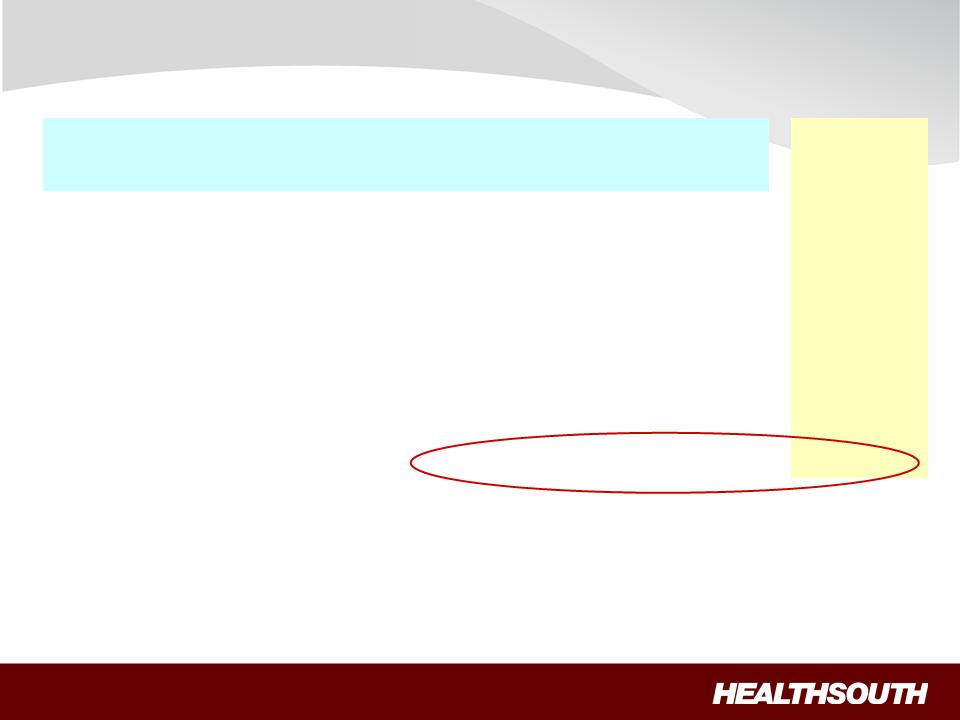
19
Operational
Excellence = “Cost-Effective” Care
CMS
Fiscal Year 2010 IRF Rate Setting File Analysis (1)
|
|
Freestanding
(2) |
Units
(2)
|
Total
|
|
HealthSouth
|
|
|
Hospitals
(2)
|
||||
|
Number
of IRFs
|
228
|
953
|
1,181
|
|
94
|
|
Average
# of Discharges per IRF
|
649
|
237
|
316
|
|
822
|
|
Outlier
Payments as % of Total
Payments |
1.32%
|
4.08%
|
3.00%
|
|
0.43%
|
|
Average
Estimated Total Payment
per Discharge for FY 2010 |
$16,452
|
$16,741
|
$16,626
|
|
$15,996
|
|
Average
Estimated Cost per
Discharge for FY 2010 |
$14,021
|
$17,207
|
$15,945
|
|
$12,633
|
Notes:
(1) All
data provided was filtered and compiled from the Centers for Medicare and
Medicaid Services (CMS) Fiscal Year 2010 IRF rate setting final
rule file found at http://www.cms.hhs.gov/InpatientRehabFacPPS/07_DataFiles.asp#TopOfPage. The data presented was developed entirely by
CMS and is based on its definitions which are different in form and substance from the criteria HealthSouth uses for external reporting purposes.
Because CMS does not provide its detailed methodology, HealthSouth is not able to reconstruct the CMS projections or the calculation.
rule file found at http://www.cms.hhs.gov/InpatientRehabFacPPS/07_DataFiles.asp#TopOfPage. The data presented was developed entirely by
CMS and is based on its definitions which are different in form and substance from the criteria HealthSouth uses for external reporting purposes.
Because CMS does not provide its detailed methodology, HealthSouth is not able to reconstruct the CMS projections or the calculation.
(2) The
CMS file contains data for each of the 1,181 inpatient rehabilitation facilities
used to estimate the policy updates for the FY 2010 Final IRF-
PPS Rule. Most of the data represents historical information from the CMS fiscal year 2008 period and does not reflect the same HealthSouth
hospitals in operation today. The data presented was separated into three categories: Freestanding, Units, and HealthSouth. HealthSouth is a
subset of Freestanding and the Total.
PPS Rule. Most of the data represents historical information from the CMS fiscal year 2008 period and does not reflect the same HealthSouth
hospitals in operation today. The data presented was separated into three categories: Freestanding, Units, and HealthSouth. HealthSouth is a
subset of Freestanding and the Total.
Exhibit
99.2
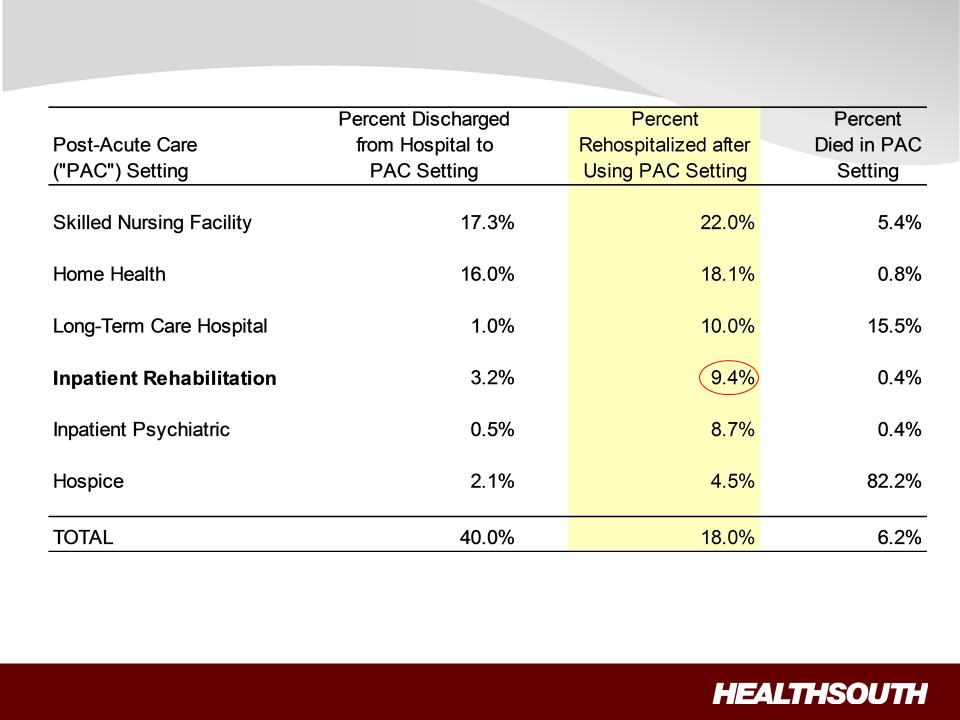
20
IRFs
have Lower Readmission Rates
Note: Use of
home health care and hospice is based on care that starts within three days of
discharge. Other
PAC care starts within one day of
discharge. Home health use includes episodes that overlap an inpatient stay.
discharge. Home health use includes episodes that overlap an inpatient stay.
Source: Medicare Payment
Advisory Commission, “A Data Book: Healthcare
spending and the Medicare program,” Chart 9-3 (June
2008)
Exhibit
99.2
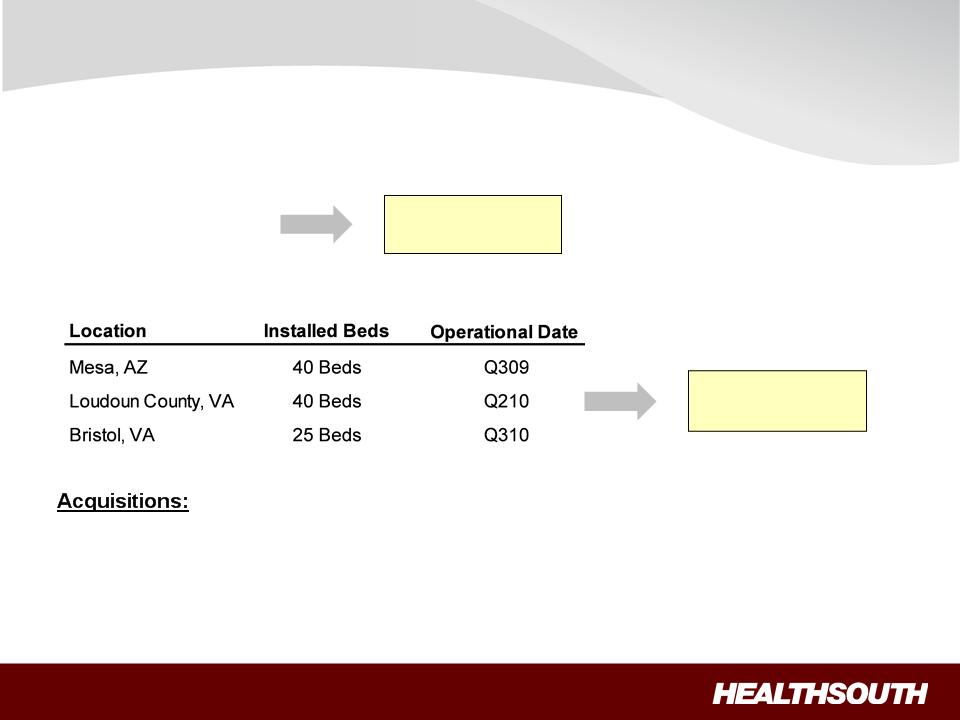
21
Capacity
expansions:
• Approximately 100
beds added in 2010.
• Average investment
per bed including renovation:
– $100K to
$250K
De
novos:
• Expanded joint
venture with St. Vincent Health System in Little Rock, AR, through the
purchase of a 23-bed rehabilitation unit.
purchase of a 23-bed rehabilitation unit.
• Acquired the
rehabilitation unit in Altoona, PA, through a newly formed joint venture
and
relocated its operations to one of our hospitals.
relocated its operations to one of our hospitals.
Organic
Growth
Cash
pay-back:
6 - 7
years
Cash
pay-back:
2 - 4 years
2 - 4 years
Exhibit
99.2
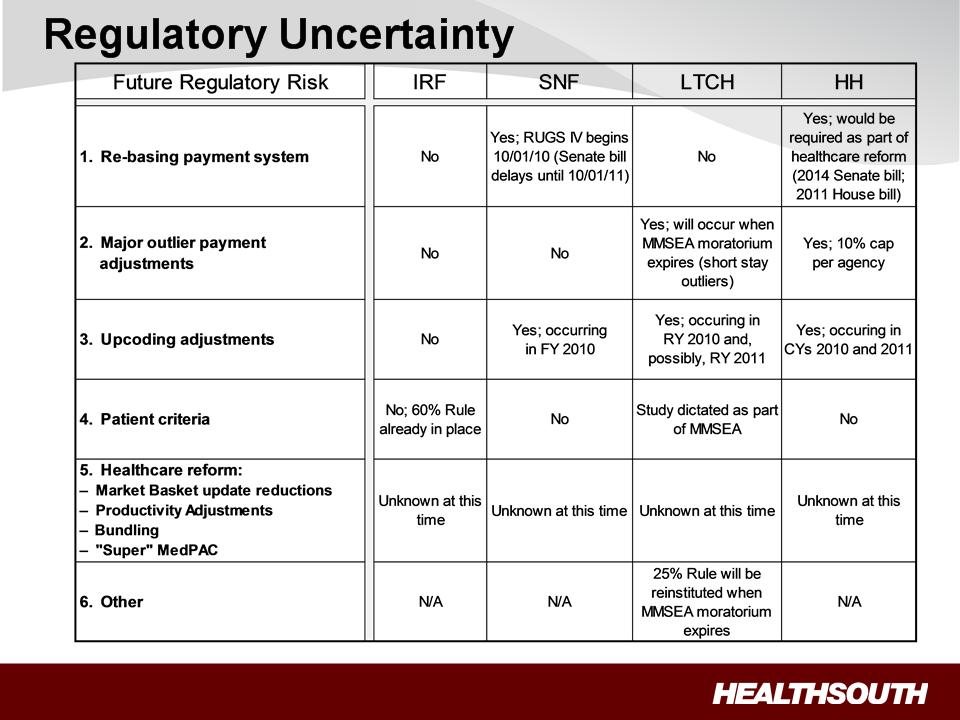
22
Sources: Senate
Reform Bill, CMS Regulatory published rules and MMSEA
Exhibit
99.2
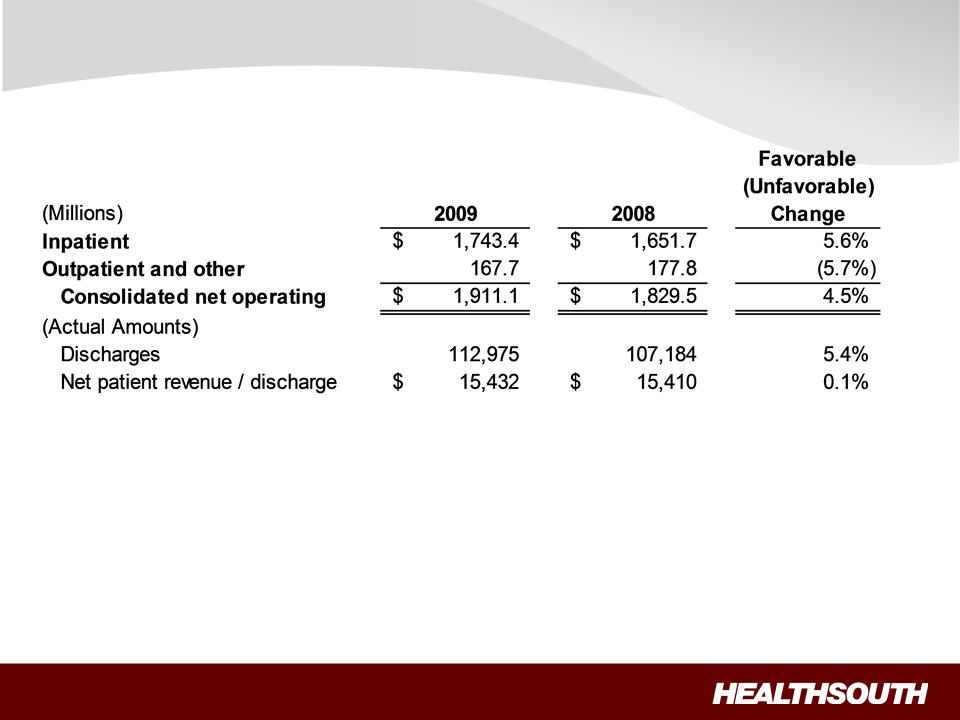
23
Revenues
(Year-End)
Exhibit
99.2
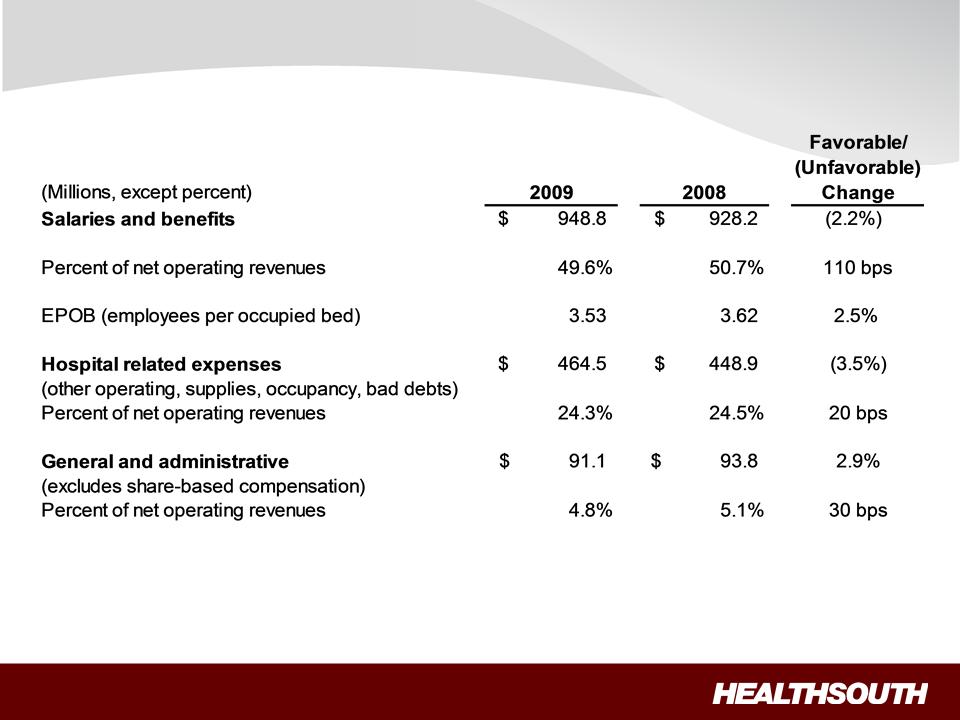
24
Expenses
(Year-End)
Exhibit
99.2
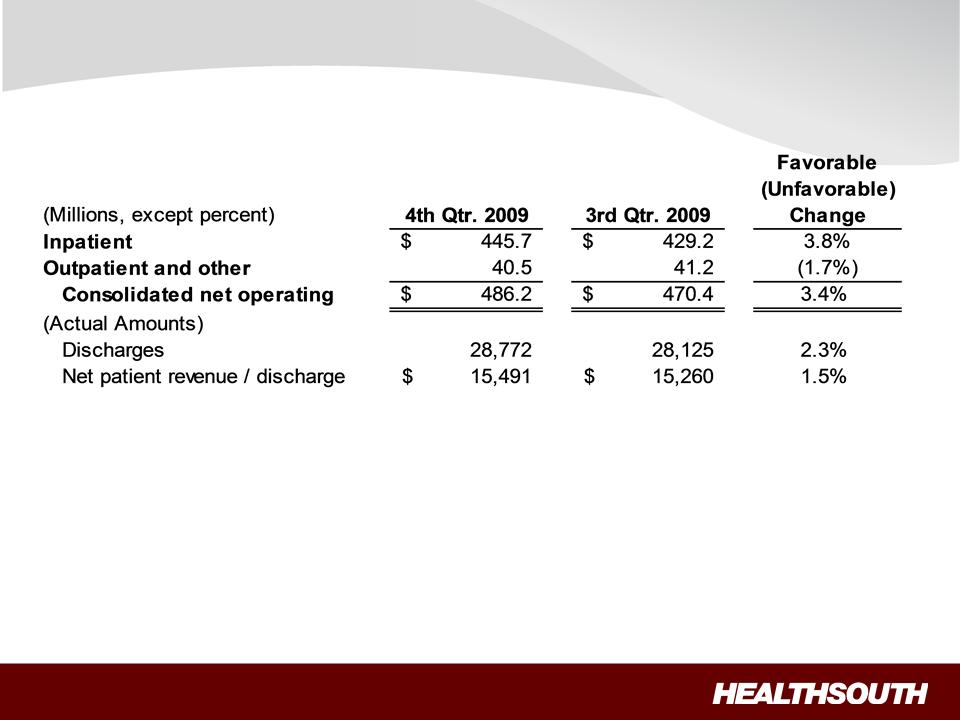
25
Revenues
(Sequential)
Exhibit
99.2
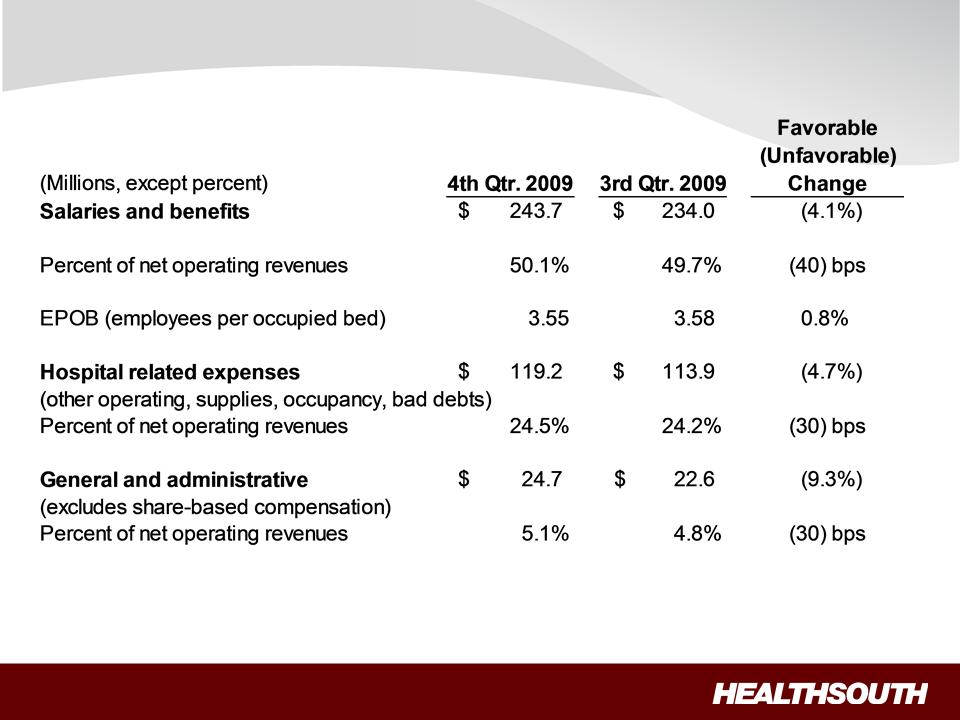
26
Expenses
(Sequential)
Exhibit
99.2
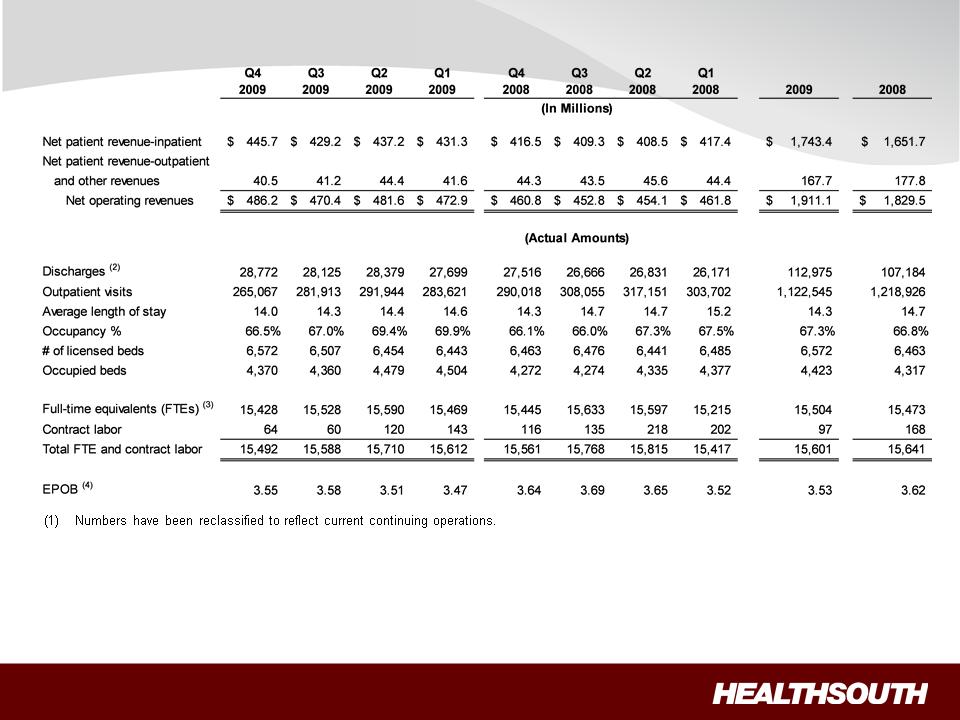
27
Operational
and Labor Metrics (1)
(2) Represents
discharges from HealthSouth’s 90 consolidated hospitals, which includes Mesa,
Arizona starting in Q3 2009.
(3) Excludes
approx. 400 full-time equivalents, who are considered part of corporate overhead
with their salaries and benefits included in general
and administrative expenses in the Company’s condensed consolidated statements of operations. Full-time equivalents included in the above
table represent HealthSouth employees who participate in or support the operations of the Company’s hospitals.
and administrative expenses in the Company’s condensed consolidated statements of operations. Full-time equivalents included in the above
table represent HealthSouth employees who participate in or support the operations of the Company’s hospitals.
(4) Employees
per occupied bed, or “EPOB,” is calculated by dividing the number of full-time
equivalents, including an estimate of full-time
equivalents from the utilization of contract labor, by the number of occupied beds during each period. The number of occupied beds is determined
by multiplying the number of licensed beds by the Company’s occupancy percentage.
equivalents from the utilization of contract labor, by the number of occupied beds during each period. The number of occupied beds is determined
by multiplying the number of licensed beds by the Company’s occupancy percentage.
Exhibit
99.2
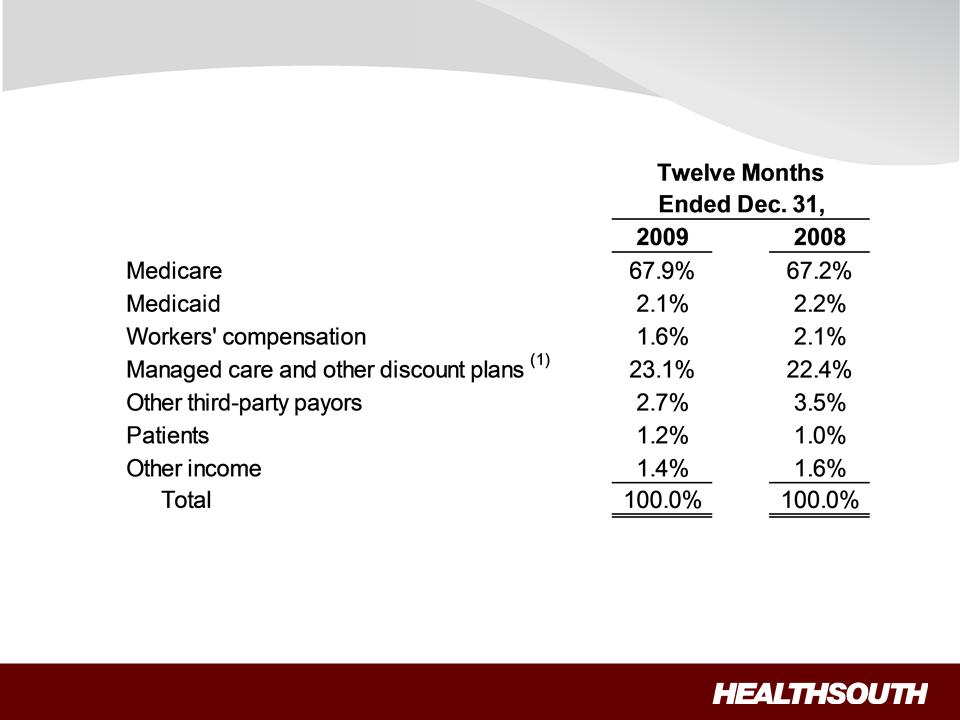
28
Payment
Sources
(1) Managed
Medicare revenues represent ~ 8% and 6% of total revenues for 2009 and 2008,
respectively, and are included in “Managed care
and other discount plans.”
and other discount plans.”
Exhibit
99.2
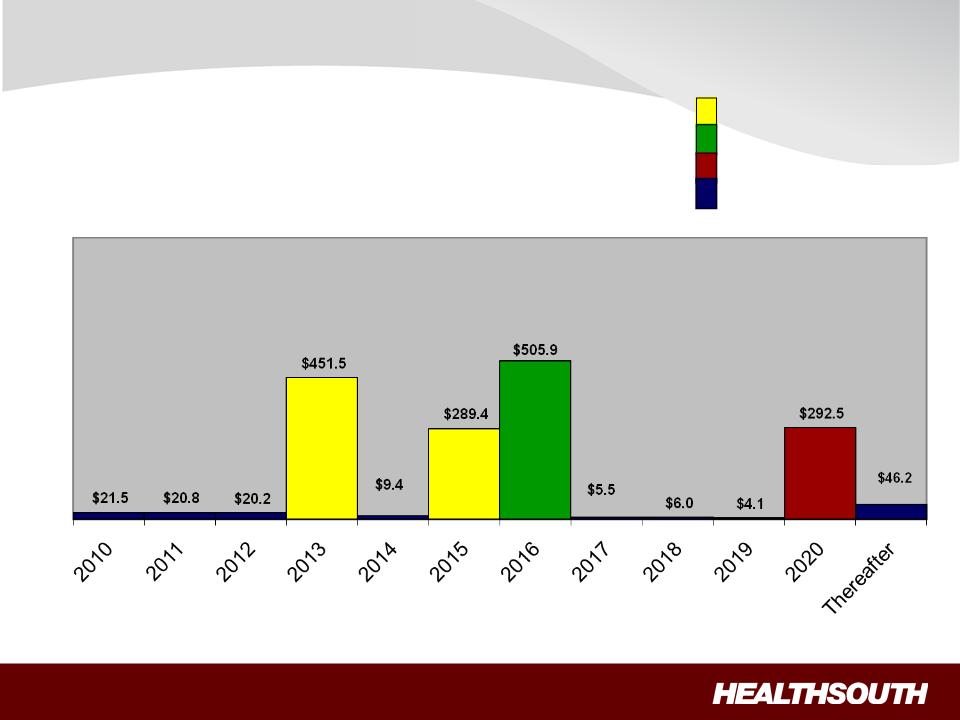
29
Debt
Maturities: No
Near-Term Financing Needs
(Millions)
= Term
Loan maturities
= 10.75%
Fixed
= 8.125%
Fixed
= Capital
leases and term
loan amortization
loan amortization
As
of December 31, 2009
Exhibit
99.2
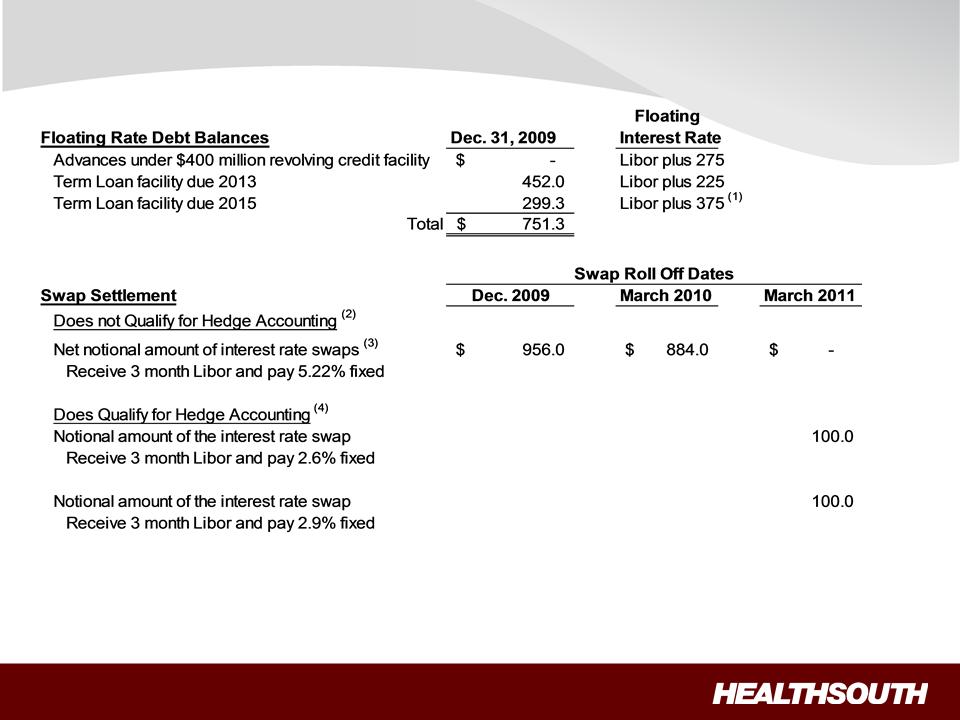
30
Interest
Rate Swaps: as
of December 31, 2009
(Millions)
(Millions)
(1) In
October 2009, the credit agreement was amended. The maturity for $300 million of
the term loan has been extended to 2015. The extended portion
of the
term loan will bear an interest rate of Libor plus 375.
(2) Cash
settlements flow through investing activities.
(3) In June
2009, we entered into a receive-fixed rate swap as a mirror offset to $100.0
million of the $1,056 million interest rate swap.
(4) Forward-starting
interest rate swaps (designated as cash flow hedges). Cash settlements will flow
through operating activities as part of interest
expense.
Exhibit
99.2
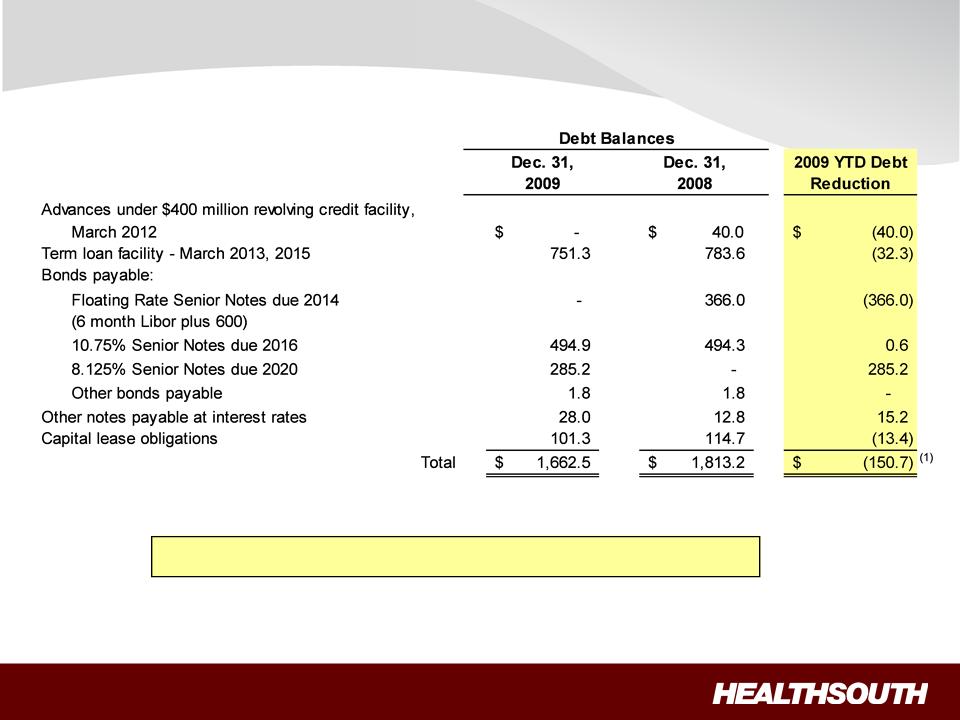
31
Debt
Schedule
(Millions)
(Millions)
(1) The
Company had $80.9 million in cash and cash equivalents as of December 31,
2009.
(2) Based
on four quarter trailing Adjusted Consolidated EBITDA of $383.0 million and
$341.2 million, respectively. See reconciliation to GAAP
on slides 34 through 35.
on slides 34 through 35.
Debt
to EBITDA(2) 4.3x 5.3x
Exhibit
99.2
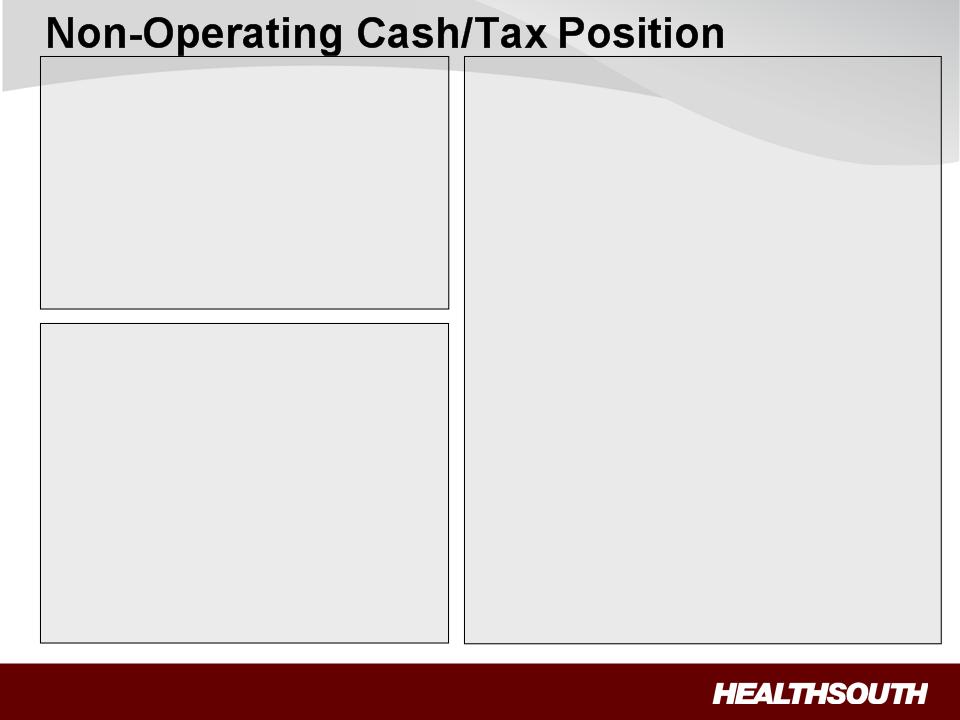
32
Cash
Refunds as of Dec. 31, 2009
• Federal tax
recoveries virtually complete.
– Approx. $43 million
received.
• State tax refunds in
progress.
– Approx. $21 million
received.
– Approx. $10 million
net receivable on
the
balance sheet.
Future
Cash Tax Payments
• Expect to pay about
$5-7 million per year of income
tax.
tax.
– State
income tax.
– Alternative
Minimum Tax (AMT).
• The Company does not
expect to pay significant
federal income taxes for the next 10-12 years, due
to approximately $905 million in deferred tax assets
as of 12/31/09 outlined in the Form 10-K to be filed
with the SEC. The majority of the deferred tax asset
is related to net operating losses (NOLs).
federal income taxes for the next 10-12 years, due
to approximately $905 million in deferred tax assets
as of 12/31/09 outlined in the Form 10-K to be filed
with the SEC. The majority of the deferred tax asset
is related to net operating losses (NOLs).
– At this
time, we do not believe the use
of NOLs
will be limited before they
expire,
however, no assurances can
be
provided.
• HealthSouth is not
currently subject to an annual
use limitation (AUL) under the Internal Revenue
Code section 382.
use limitation (AUL) under the Internal Revenue
Code section 382.
• If we experienced a
“change of ownership” as
defined by the Internal Revenue Code section 382,
we would be subject to an AUL, which is equal to
the value of the company at the time of the “change
of ownership” multiplied by the long-term tax exempt
rate.
defined by the Internal Revenue Code section 382,
we would be subject to an AUL, which is equal to
the value of the company at the time of the “change
of ownership” multiplied by the long-term tax exempt
rate.
GAAP
Considerations
• HealthSouth’s
balance sheet currently
reflects a valuation allowance for the
potential value of NOLs and future
deductions. The valuation allowance is
approximately $893 million.
reflects a valuation allowance for the
potential value of NOLs and future
deductions. The valuation allowance is
approximately $893 million.
• GAAP tax rate will
net to small amount for
foreseeable future as there will be a
reduction in the valuation allowance when
NOLs are utilized.
foreseeable future as there will be a
reduction in the valuation allowance when
NOLs are utilized.
Exhibit
99.2
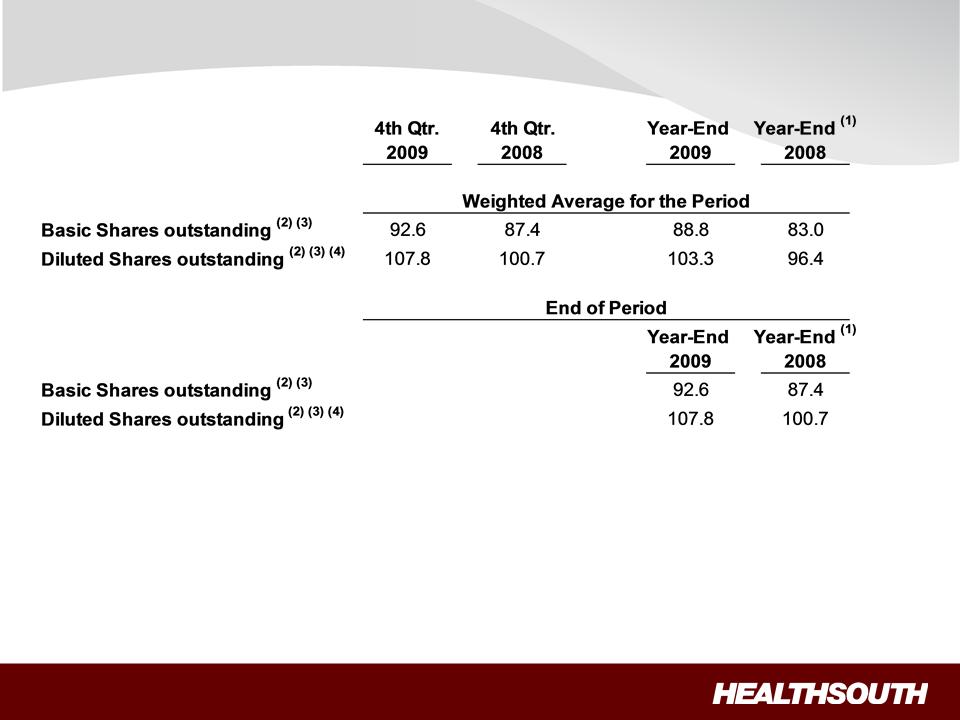
33
Outstanding
Share Summary
(Millions)
(Millions)
Notes:
(1) Completed
an equity offering for 8.8 million shares on June 27, 2008.
(2) Does not
include 2.0 million warrants issued in connection with a January 2004 loan
repaid to Credit Suisse First Boston. In connection with this
transaction, we issued warrants to the lender to purchase two million shares of our common stock. Each warrant has a term of ten years from the
date of issuance and an exercise price of $32.50 per share. The warrants were not assumed exercised for dilutive shares outstanding because
they were antidilutive in the periods presented.
transaction, we issued warrants to the lender to purchase two million shares of our common stock. Each warrant has a term of ten years from the
date of issuance and an exercise price of $32.50 per share. The warrants were not assumed exercised for dilutive shares outstanding because
they were antidilutive in the periods presented.
(3) The
agreement to settle our class action securities litigation received final court
approval in January 2007. These shares of common stock and
warrants were issued on September 30, 2009. The 5.0 million of common shares are now included in the outstanding shares. The warrants at a
strike price of $41.40 were not assumed exercised for the dilutive shares outstanding because they are anti-dilutive in the periods presented.
warrants were issued on September 30, 2009. The 5.0 million of common shares are now included in the outstanding shares. The warrants at a
strike price of $41.40 were not assumed exercised for the dilutive shares outstanding because they are anti-dilutive in the periods presented.
(4) The
difference between the basic and diluted shares outstanding is primarily related
to our convertible perpetual preferred stock.
Exhibit
99.2
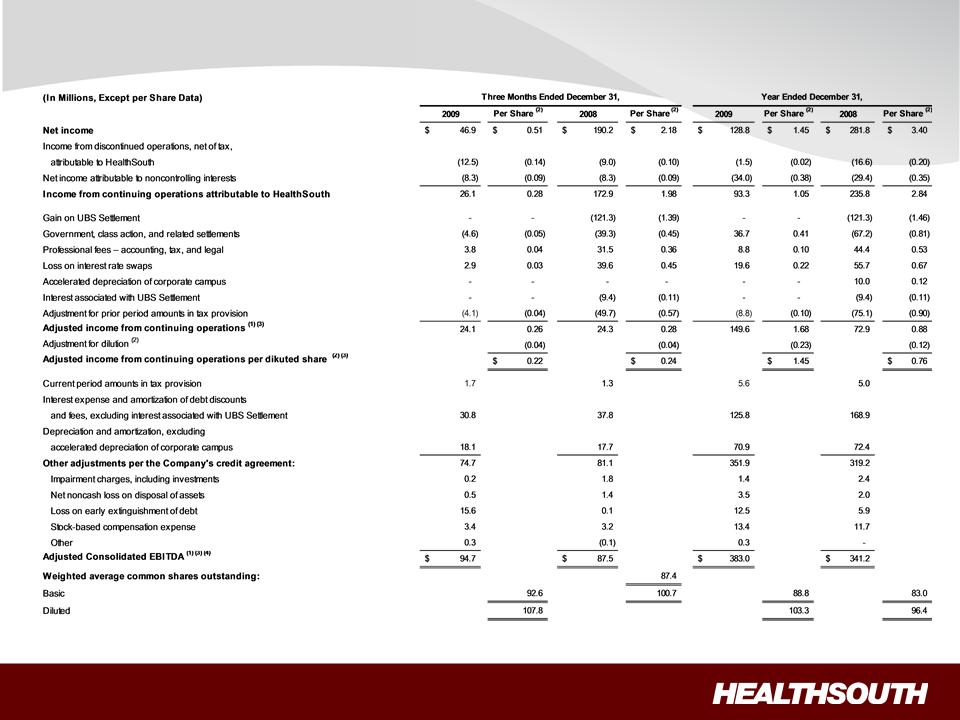
34
Three
& Twelve Months Reconciliation of Net Income to Adjusted Income
from Continuing Operations and Adjusted Consolidated EBITDA (1) (3)
from Continuing Operations and Adjusted Consolidated EBITDA (1) (3)
(1) (2) (3) (4) -
Notes
on page 35.
Exhibit
99.2
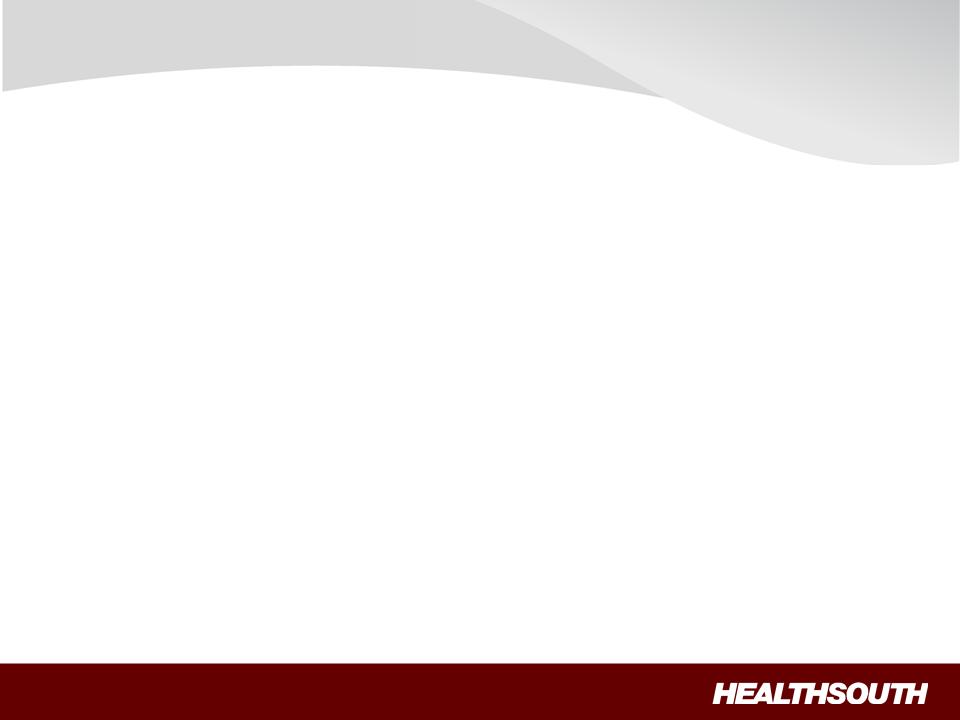
35
Reconciliation
Notes
1. Adjusted income from
continuing operations and Adjusted Consolidated EBITDA are
non-GAAP financial measures. The Company’s leverage ratio (Total Consolidated Debt
to Adjusted Consolidated EBITDA for the trailing four quarters) is, likewise, a non-GAAP
financial measure. Management and some members of the investment community
utilize adjusted income from continuing operations as a financial measure and Adjusted
Consolidated EBITDA and leverage ratio as liquidity measures on an ongoing basis.
These measures are not recognized in accordance with GAAP and should not be
viewed as an alternative to GAAP measures of performance or liquidity. In evaluating
these adjusted measures, the reader should be aware that in the future HealthSouth
may incur expenses similar to the adjustments set forth above.
non-GAAP financial measures. The Company’s leverage ratio (Total Consolidated Debt
to Adjusted Consolidated EBITDA for the trailing four quarters) is, likewise, a non-GAAP
financial measure. Management and some members of the investment community
utilize adjusted income from continuing operations as a financial measure and Adjusted
Consolidated EBITDA and leverage ratio as liquidity measures on an ongoing basis.
These measures are not recognized in accordance with GAAP and should not be
viewed as an alternative to GAAP measures of performance or liquidity. In evaluating
these adjusted measures, the reader should be aware that in the future HealthSouth
may incur expenses similar to the adjustments set forth above.
2. Per share amounts
for each period presented are based on basic weighted average
common shares outstanding for all amounts except adjusted income from continuing
operations per diluted share, which is based on diluted weighted average shares
outstanding. The difference in shares between the basic and diluted shares outstanding
is primarily related to our convertible perpetual preferred stock.
common shares outstanding for all amounts except adjusted income from continuing
operations per diluted share, which is based on diluted weighted average shares
outstanding. The difference in shares between the basic and diluted shares outstanding
is primarily related to our convertible perpetual preferred stock.
3. Adjusted income from
continuing operations per diluted share and Adjusted
Consolidated EBITDA are two components of our guidance.
Consolidated EBITDA are two components of our guidance.
4. The Company’s Credit
Agreement allows certain other items to be added to arrive at
Adjusted Consolidated EBITDA, and there may be certain other deductions required.
Adjusted Consolidated EBITDA, and there may be certain other deductions required.
